Internal external: Marcus Coates’ Artangel films in Pimlico
For a new Artangel project, a series of films are presented across Pimlico, London. Each is directed by an
individual
in recovery from lived experience of psychosis, using artist Marcus Coates as a vehicle to illustrate their experiences. For recessed.space, Barney Pau took a visit to explore places - physical & psychological - normally out of public view.
Amongst the quiet streets of Pimlico, in otherwise
unremarkable locations, five screens display The Directors, a series of new collaborative works led by artist Marcus Coates after he researched and observed the work of psychiatrist Dr. Isabel Valli from 2017. Dr. Valli specialised in patients recovering from psychosis, since becoming an advisor to the Artangel project. Each
short film is directed by a patient recovering from psychosis who Coates met through mental health charities, and each offers a unique
insight into the surreal reality of psychosis by recreating the lived
experience of a psychotic episode through Coates.
Lost between the real and the intangible, the contrast between a residential Pimlico landscape and these personal dystopic surrealities facilitates the visitor's immersion in an unfamiliar world where they don’t know what is real and what is not. Journeying between these nondescript locations one feels a sense of secrecy, of hiding in plain sight, as the quotidian of London life merges with the directors’ dramatic mindscapes of paranoia, filled with non-existent voices and hallucinatory experiences.
![]()
![]()
Without any lived experience of psychosis, one might find it hard to feel trapped in these alternative realities, yet from their director’s chair each patient paints a vivid and nuanced experience. Psychosis supplements reality with surreality, playing tricks on the mind of those who experience episodes - as Valli explains in an interview published in the exhibition guide, these episodes can involve disturbances in any perceptive domain. Hallucinations are not limited to audio-visual fields, and can affect smell, taste, and touch. These almost intangible perceptions become indistinguishable from reality, creating an immersive sensory experience that can completely engulf those who have psychosis, isolating them in their alternative realities.
The directors work with Coates to create an unreal space located in his mind. We are privy to his isolating experience, but we cannot feel what he feels. In this, the production excels, extending Coates’ pseudo-psychosis to envelop the viewer. My palms sweated at Coates’ palpable anxiety, and I questioned myself through his self-doubt. To communicate this, the directors and production team employ the complete suite of cinematic and theatrical techniques, from full scale stage-sets to casts of supporting actors, all to facilitate the artists’ - and his audiences’ - total immersion.
![]()
![]()
Through sensory deprivation, or saturation, Coates’ agency becomes completely subject to each director, and his synthesised psychosis only relents when they believe he has experienced an episode similar to their own. By foregoing agency, and placing himself in their hands, Coates enables each director to communicate in a medium that grants them full control over him. He reasons with them, pleads, and tells them he’s uncomfortable, breaking down in emotional exhaustion.
Lost in intangible voids, the only voices of reason become the directors’, yet it is their direction that leads us away from our own rationality. This paradoxical experience sets a scene we may find confusing, in which we cannot distinguish the floor from the walls. We sit in Lucy’s bedroom and see Coates shaking its walls before exiting what we then realise is a replica stage-set. Into this set, Lucy’s hands then descend, and it becomes an equally convincing miniature. In Marcus’ film we are on a stage, watched by a passive audience, yet he has convinced us we’re on a bus. Stephen tells us that everyone is conspiring against us, where Mark says they are in fact worshipping us, and Anthony makes us doubt whether our own mother is indeed who we think she is. Each director tells us what to believe, yet what they say is alien to our regular thoughts.
![]()
![]()
One key theme that is played with throughout is familiarity. Through an ongoing tension between private and public space, each director illustrates the tumult of their experiences. This familiarity is not just centred on the setting of each film, but also on how one connects with it personally. If some films resound more than others, it reveals how individual each lived experience is. The feeling of immersion, of connection that one feels, and the affinity to each director’s film, is indicative of our connectivity to this experience; of the relatability and familiarity that these insecurities and surrealities might play on in our own minds.
The message communicated by Coates’ medium speaks volumes. Cinematography is rarely without agency - in photography, direction, production, lighting, and set-design, each decision made is inherently agential, and intrinsic in the creation of a vicarious experience. Directing a uniquely individual experience, such as the simulation of a psychotic episode, enables each patient to communicate their otherwise impenetrable worlds in a widely understood medium. Leaning on cinematic and theatrical tropes serves to strengthen this, by presenting the experience in a familiar, communicable format.
![]()
![]()
Filming each episode in different, yet recognisable London locations, as well as nondescript domestic settings, makes them eminently relatable; it could be you in that film, those voices could be in your head. It’s hard to know to what degree Coates signs over his autonomy, and how much he subconsciously retains; indeed, how easy it is for anyone to wholeheartedly embed themselves in a surreality within reality? Yet, by allowing each patient full directorial control, Coates, in spite of his reactions, is guided through their challenging experiences to create what appears an authentic insight into psychosis. I am left wondering whether, when Coates got home to his own familiar place, and when he stepped out the door the next day, his experiences stayed with him; indeed, whether my experience will stay with me.
Each screen is so embedded in the local infrastructure that it must be sought to be found. Access to Marcus’ film in an upstairs back-room of the Churchill Gardens Estate Residents’ Association takes you past a mid-century bar playing lilting music. Push open the newspapered doors of a closed Pimlico Spice to find Stephen’s screening, and walk past the reception of Pimlico Health to get to the basement storeroom showing Anthony’s film. In Lucy’s fifth floor flat in Chaucer House, the hallways leads you past the living room and kitchen before you reach the screening in her bedroom, and to access Mark’s film you have to pick your way through the jumble of a vintage store. Such everyday locations make you feel like you are intruding, while also being welcome - a continued play on familiarity.
![]()
![]()
Set in the shadow of an institution like the Tate Britain, the subtlety of Coates’ chosen locations speaks volumes about the work. Each director lives a life unknown to us, and such quotidian spaces make us feel like we are lost in this surreality within reality. Moving through such an everyday urban landscape as an audience, you get the feeling you represent unfamiliarity, that, despite the insight each film gives you, you will never truly know the directors’ experiences. This balance becomes key in communicating the isolation of psychosis. The contrast between the realness of each site, and the unreality of the scenarios screened within, is a poignant reminder of the challenges that each of the directors faces. Knowing only the present reality while experiencing a psychotic episode, but retrospectively knowing that none of it was in fact real, must be a mind-bending play on perception that most of us do not have to endure.
Shifting between reality and surreality, isolation and connectivity, familiarity and unfamiliarity, each film works in its own way to create a unique and shifting experience. This is brought into context by the last location, where Jane, the proprietress of a cluttered vintage store called The Cave, ushers me in and offers me a cup of tea. Before she leaves me to settle in to watch the film, I ask her about the engagement Coates and Artangel have made with the local community. Born and raised in Pimlico, Jane plays an active role at her local community centre and, as a member of the Tate advisory board, is tasked with engaging the local residents with the gallery. She sees a divide between the gallery and its neighbours, and speaks with disinterest of the pomp of the institutional Art World.
![]()
![]()
She recounts a story of a Tate opening she attended. Frustrated at not being able to see the works, she asked the assorted paparazzi and glitterati to move aside to get a better look, only realising in retrospect that she had unwittingly told the artist to get out of the way. Her role at Tate is, as she puts it, to make people who feel like they don’t belong, belong, so when she is forthcoming in her praise about Coates’ and Artangel’s local engagement, it becomes indicative that uniting the community was imperative to their project. As she walks out of the screening room, she points out the new door and mentions the fresh coat of paint, before telling me that all the assorted vintage chairs are also for sale.
Through their direction, each patient makes the isolation of psychosis tangibly real; the singular worlds in which they have been adrift become shared experiences in which we can vicariously partake. It is poignant, then, that Coates and Artangel have taken their time to engage with the local community. Their investment in local infrastructure is a reminder to the audience of the strength and unity of a community, especially for those most isolated.
![]()
Lost between the real and the intangible, the contrast between a residential Pimlico landscape and these personal dystopic surrealities facilitates the visitor's immersion in an unfamiliar world where they don’t know what is real and what is not. Journeying between these nondescript locations one feels a sense of secrecy, of hiding in plain sight, as the quotidian of London life merges with the directors’ dramatic mindscapes of paranoia, filled with non-existent voices and hallucinatory experiences.

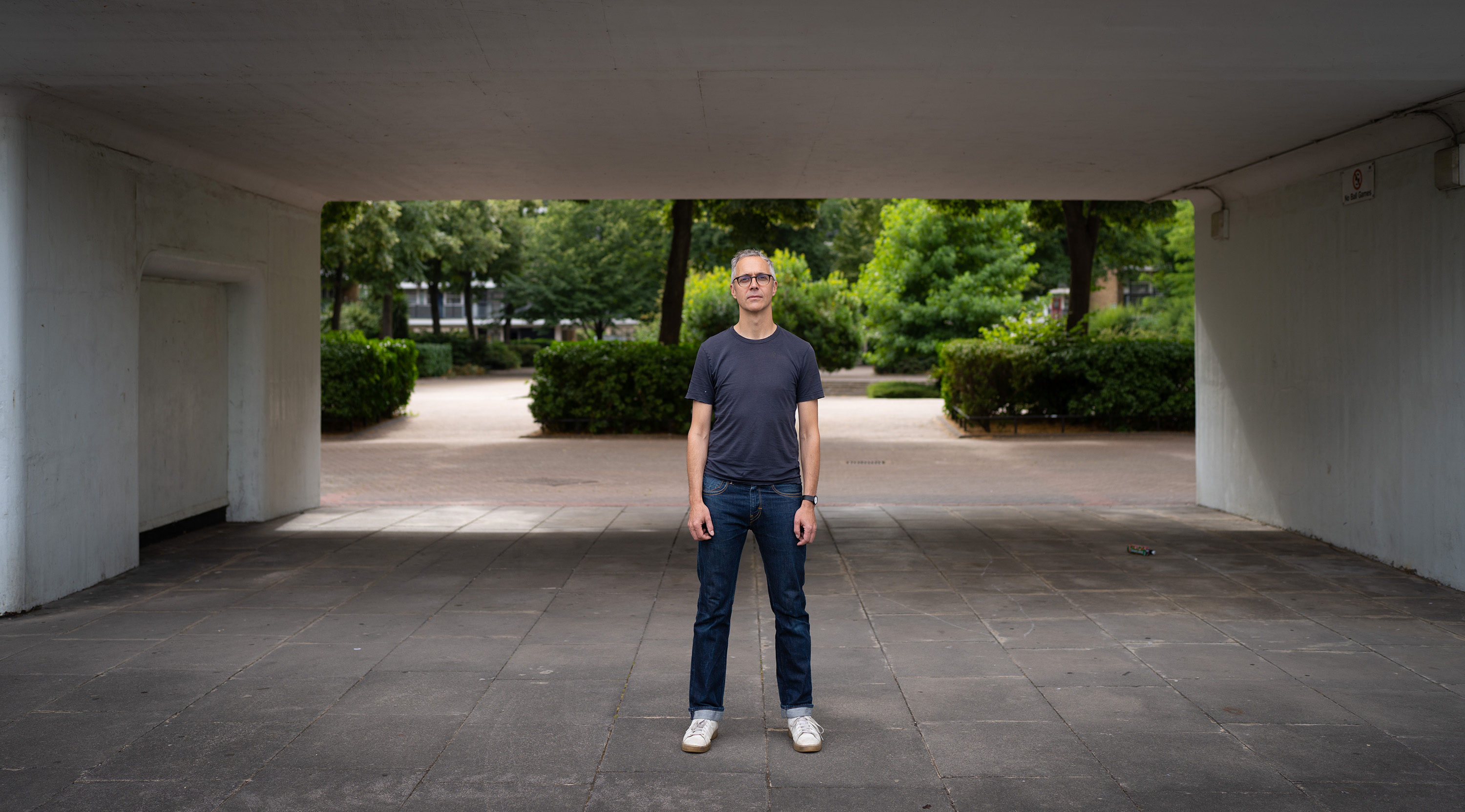
figs.i,ii
Without any lived experience of psychosis, one might find it hard to feel trapped in these alternative realities, yet from their director’s chair each patient paints a vivid and nuanced experience. Psychosis supplements reality with surreality, playing tricks on the mind of those who experience episodes - as Valli explains in an interview published in the exhibition guide, these episodes can involve disturbances in any perceptive domain. Hallucinations are not limited to audio-visual fields, and can affect smell, taste, and touch. These almost intangible perceptions become indistinguishable from reality, creating an immersive sensory experience that can completely engulf those who have psychosis, isolating them in their alternative realities.
The directors work with Coates to create an unreal space located in his mind. We are privy to his isolating experience, but we cannot feel what he feels. In this, the production excels, extending Coates’ pseudo-psychosis to envelop the viewer. My palms sweated at Coates’ palpable anxiety, and I questioned myself through his self-doubt. To communicate this, the directors and production team employ the complete suite of cinematic and theatrical techniques, from full scale stage-sets to casts of supporting actors, all to facilitate the artists’ - and his audiences’ - total immersion.
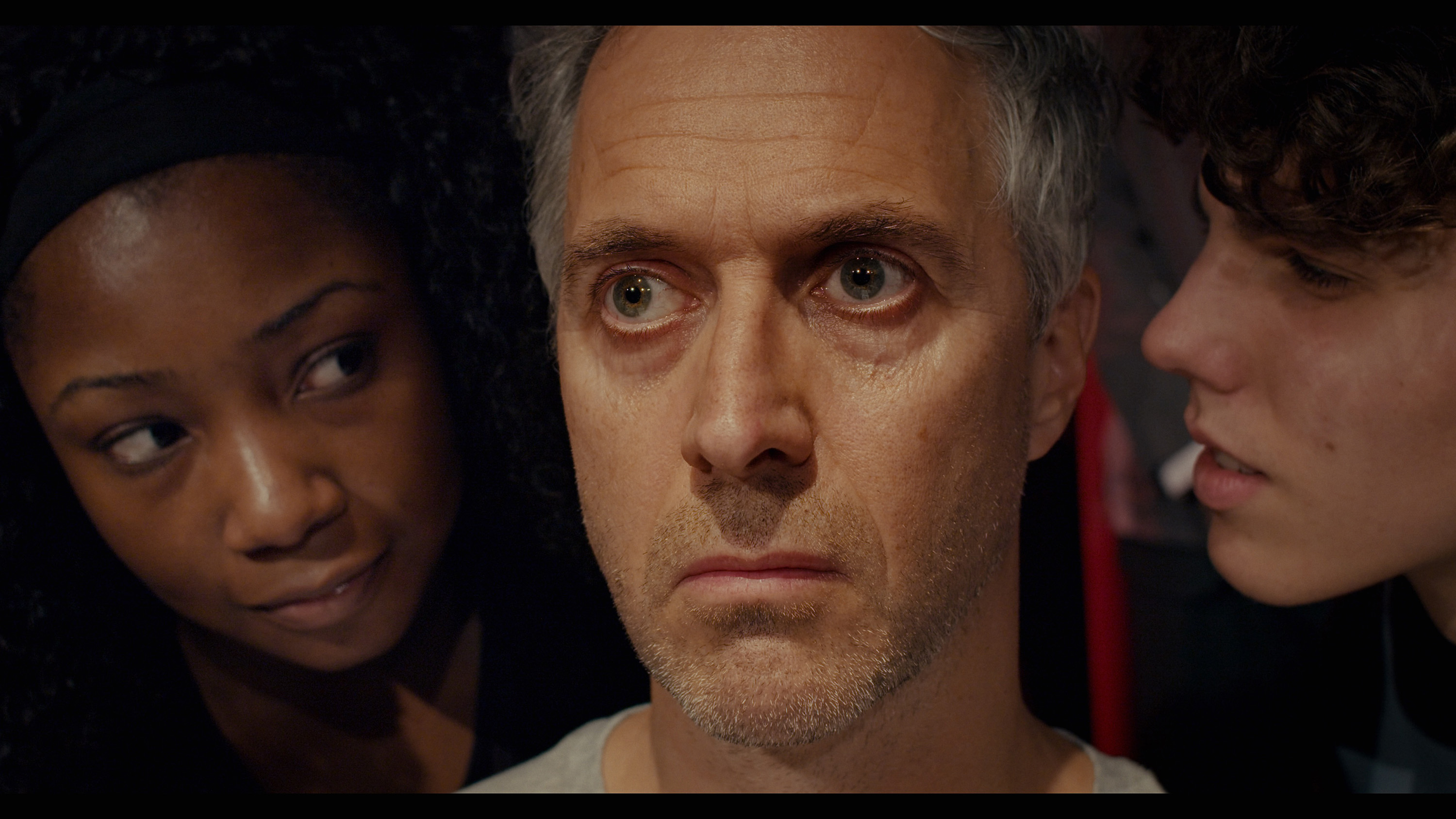

figs.iii,iv
Through sensory deprivation, or saturation, Coates’ agency becomes completely subject to each director, and his synthesised psychosis only relents when they believe he has experienced an episode similar to their own. By foregoing agency, and placing himself in their hands, Coates enables each director to communicate in a medium that grants them full control over him. He reasons with them, pleads, and tells them he’s uncomfortable, breaking down in emotional exhaustion.
Lost in intangible voids, the only voices of reason become the directors’, yet it is their direction that leads us away from our own rationality. This paradoxical experience sets a scene we may find confusing, in which we cannot distinguish the floor from the walls. We sit in Lucy’s bedroom and see Coates shaking its walls before exiting what we then realise is a replica stage-set. Into this set, Lucy’s hands then descend, and it becomes an equally convincing miniature. In Marcus’ film we are on a stage, watched by a passive audience, yet he has convinced us we’re on a bus. Stephen tells us that everyone is conspiring against us, where Mark says they are in fact worshipping us, and Anthony makes us doubt whether our own mother is indeed who we think she is. Each director tells us what to believe, yet what they say is alien to our regular thoughts.
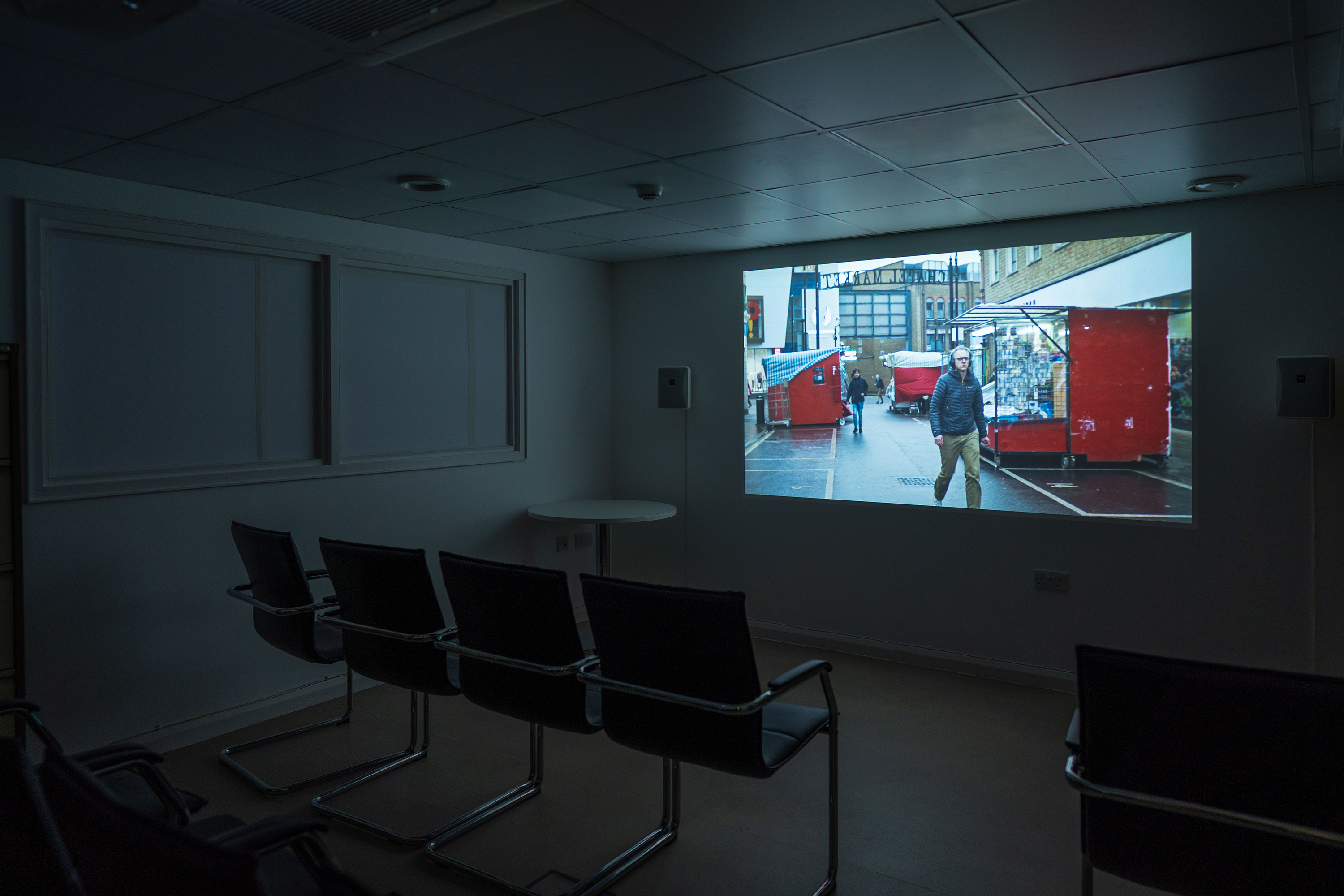

figs.v,vi
One key theme that is played with throughout is familiarity. Through an ongoing tension between private and public space, each director illustrates the tumult of their experiences. This familiarity is not just centred on the setting of each film, but also on how one connects with it personally. If some films resound more than others, it reveals how individual each lived experience is. The feeling of immersion, of connection that one feels, and the affinity to each director’s film, is indicative of our connectivity to this experience; of the relatability and familiarity that these insecurities and surrealities might play on in our own minds.
The message communicated by Coates’ medium speaks volumes. Cinematography is rarely without agency - in photography, direction, production, lighting, and set-design, each decision made is inherently agential, and intrinsic in the creation of a vicarious experience. Directing a uniquely individual experience, such as the simulation of a psychotic episode, enables each patient to communicate their otherwise impenetrable worlds in a widely understood medium. Leaning on cinematic and theatrical tropes serves to strengthen this, by presenting the experience in a familiar, communicable format.
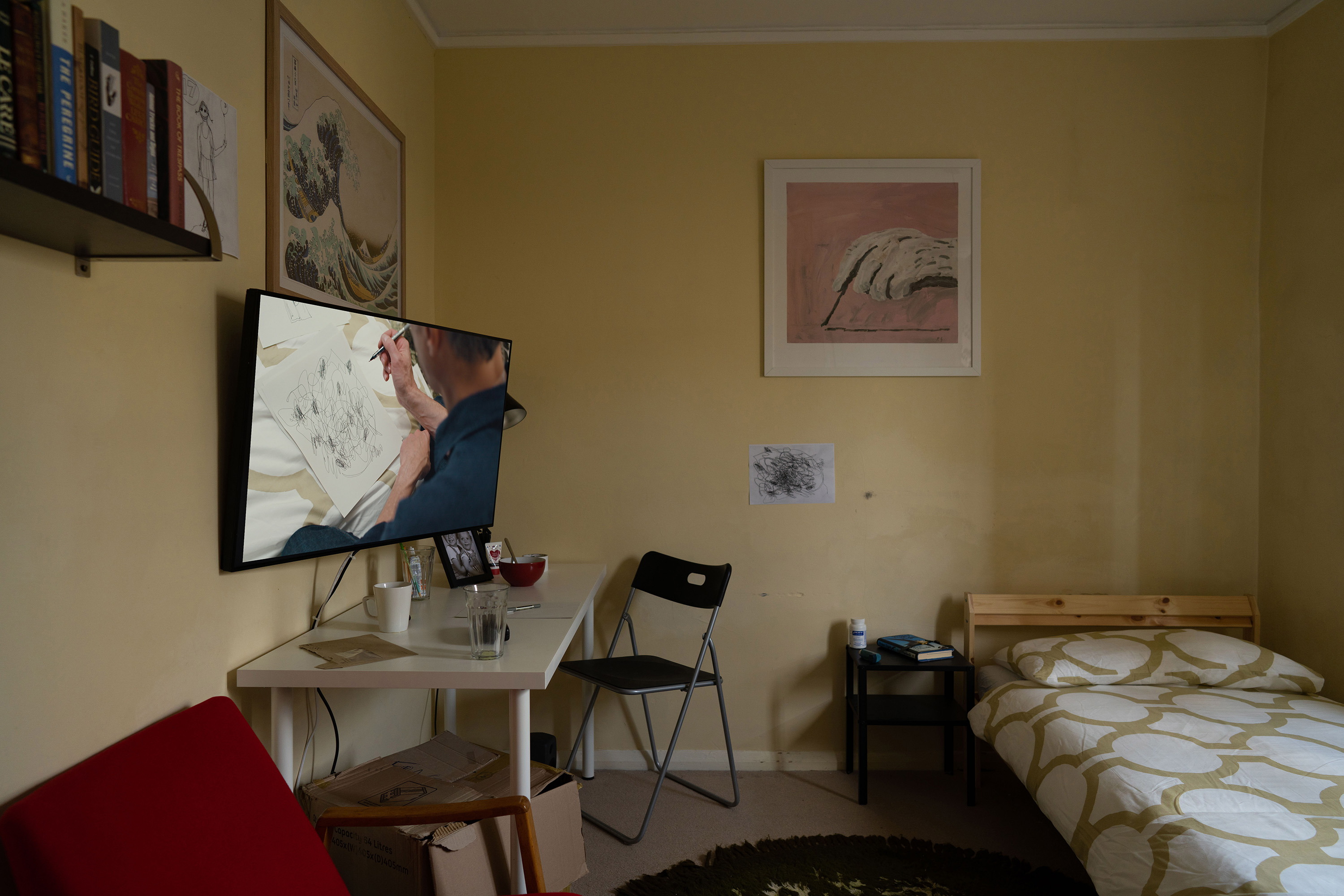

figs.vii,viii
Filming each episode in different, yet recognisable London locations, as well as nondescript domestic settings, makes them eminently relatable; it could be you in that film, those voices could be in your head. It’s hard to know to what degree Coates signs over his autonomy, and how much he subconsciously retains; indeed, how easy it is for anyone to wholeheartedly embed themselves in a surreality within reality? Yet, by allowing each patient full directorial control, Coates, in spite of his reactions, is guided through their challenging experiences to create what appears an authentic insight into psychosis. I am left wondering whether, when Coates got home to his own familiar place, and when he stepped out the door the next day, his experiences stayed with him; indeed, whether my experience will stay with me.
Each screen is so embedded in the local infrastructure that it must be sought to be found. Access to Marcus’ film in an upstairs back-room of the Churchill Gardens Estate Residents’ Association takes you past a mid-century bar playing lilting music. Push open the newspapered doors of a closed Pimlico Spice to find Stephen’s screening, and walk past the reception of Pimlico Health to get to the basement storeroom showing Anthony’s film. In Lucy’s fifth floor flat in Chaucer House, the hallways leads you past the living room and kitchen before you reach the screening in her bedroom, and to access Mark’s film you have to pick your way through the jumble of a vintage store. Such everyday locations make you feel like you are intruding, while also being welcome - a continued play on familiarity.
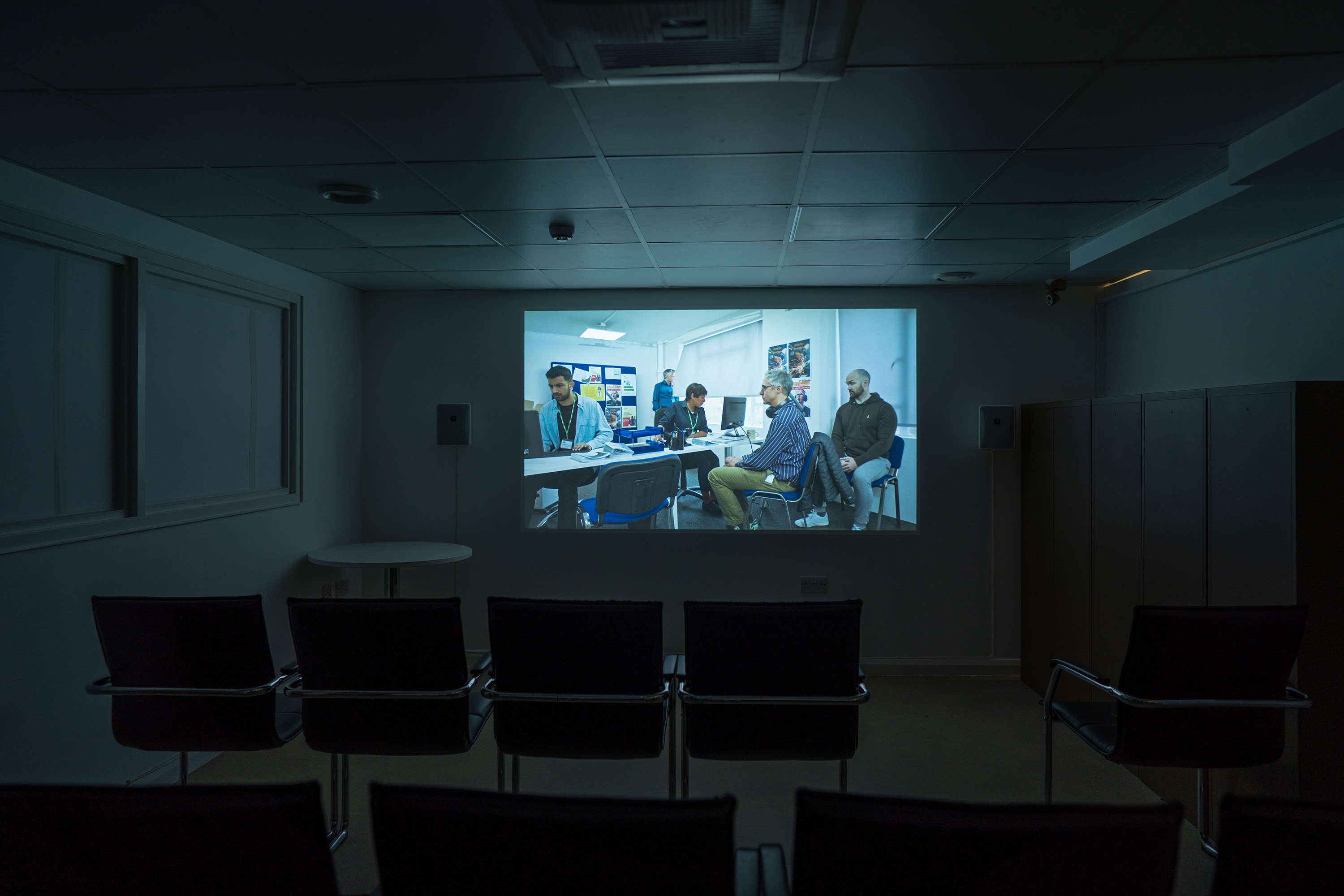

figs.ix,x
Set in the shadow of an institution like the Tate Britain, the subtlety of Coates’ chosen locations speaks volumes about the work. Each director lives a life unknown to us, and such quotidian spaces make us feel like we are lost in this surreality within reality. Moving through such an everyday urban landscape as an audience, you get the feeling you represent unfamiliarity, that, despite the insight each film gives you, you will never truly know the directors’ experiences. This balance becomes key in communicating the isolation of psychosis. The contrast between the realness of each site, and the unreality of the scenarios screened within, is a poignant reminder of the challenges that each of the directors faces. Knowing only the present reality while experiencing a psychotic episode, but retrospectively knowing that none of it was in fact real, must be a mind-bending play on perception that most of us do not have to endure.
Shifting between reality and surreality, isolation and connectivity, familiarity and unfamiliarity, each film works in its own way to create a unique and shifting experience. This is brought into context by the last location, where Jane, the proprietress of a cluttered vintage store called The Cave, ushers me in and offers me a cup of tea. Before she leaves me to settle in to watch the film, I ask her about the engagement Coates and Artangel have made with the local community. Born and raised in Pimlico, Jane plays an active role at her local community centre and, as a member of the Tate advisory board, is tasked with engaging the local residents with the gallery. She sees a divide between the gallery and its neighbours, and speaks with disinterest of the pomp of the institutional Art World.
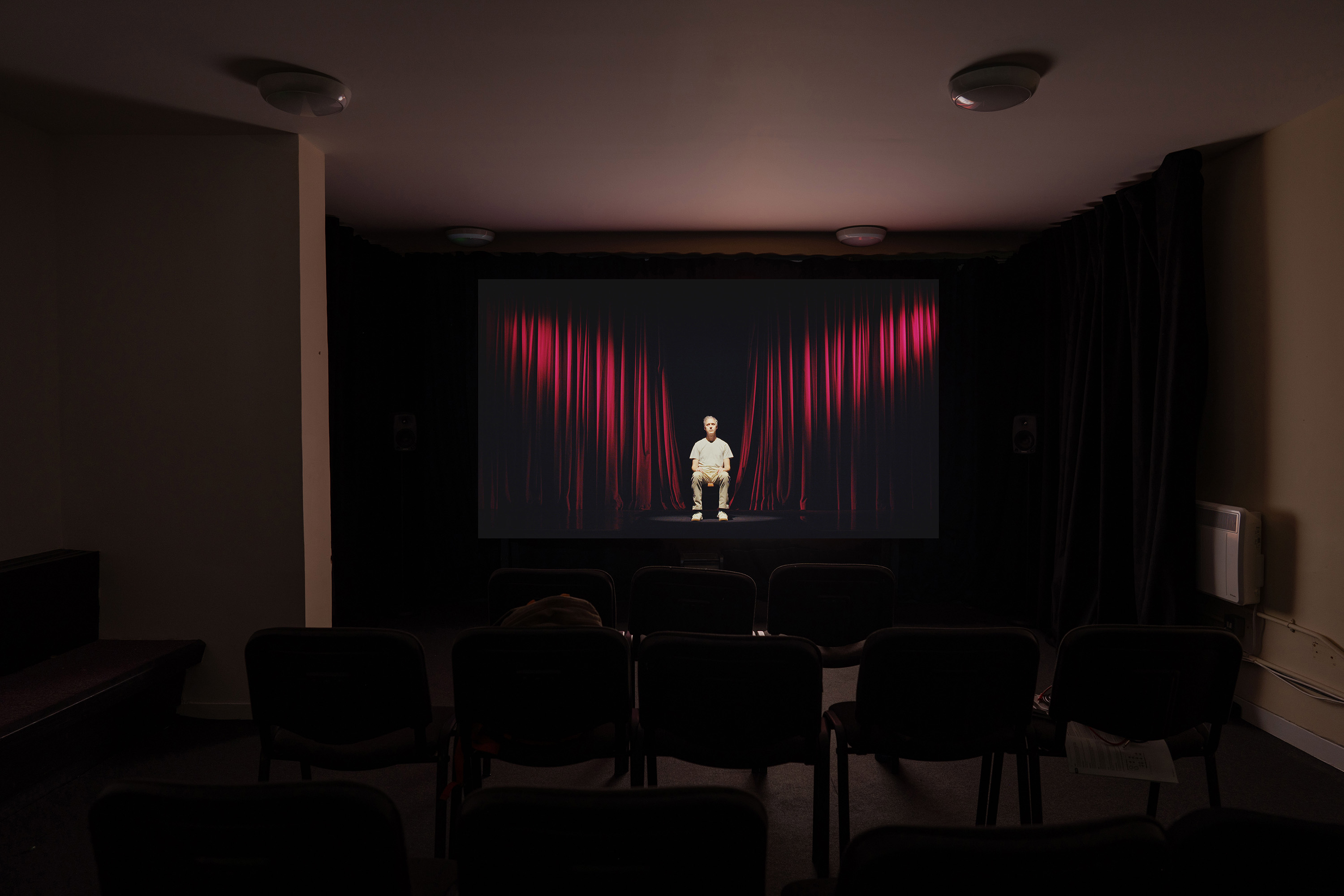
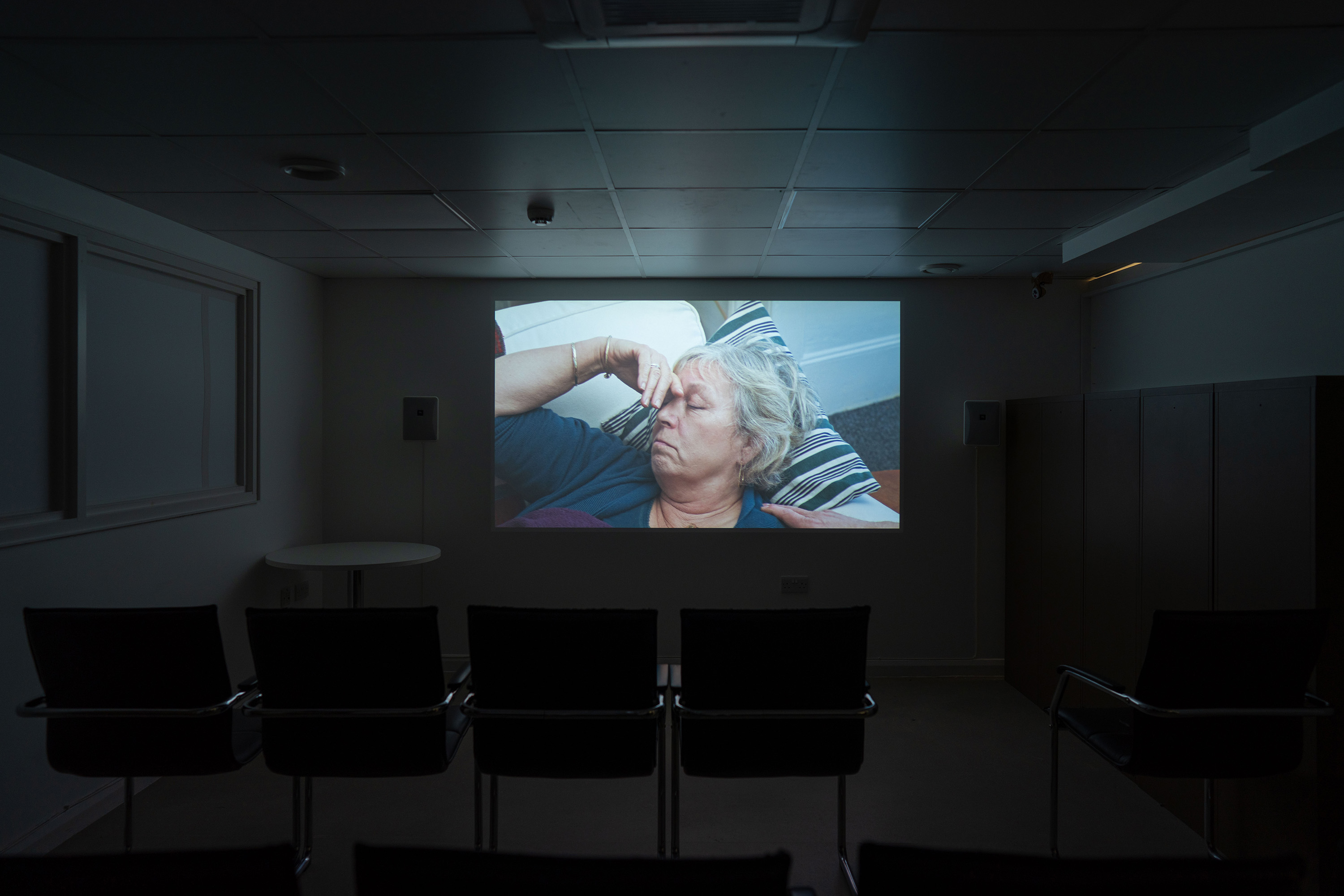
figs.xi,xii
She recounts a story of a Tate opening she attended. Frustrated at not being able to see the works, she asked the assorted paparazzi and glitterati to move aside to get a better look, only realising in retrospect that she had unwittingly told the artist to get out of the way. Her role at Tate is, as she puts it, to make people who feel like they don’t belong, belong, so when she is forthcoming in her praise about Coates’ and Artangel’s local engagement, it becomes indicative that uniting the community was imperative to their project. As she walks out of the screening room, she points out the new door and mentions the fresh coat of paint, before telling me that all the assorted vintage chairs are also for sale.
Through their direction, each patient makes the isolation of psychosis tangibly real; the singular worlds in which they have been adrift become shared experiences in which we can vicariously partake. It is poignant, then, that Coates and Artangel have taken their time to engage with the local community. Their investment in local infrastructure is a reminder to the audience of the strength and unity of a community, especially for those most isolated.

fig.xiii
Marcus Coates (b. 1968) lives & works in London. At the core of his work is a
desire to devise processes to explore the degrees to which we can understand,
know & relate to others. Often performative – using a process of radical
empathy as a motivation to create, examine & critique relational tools – he
tests actual & perceived boundaries between individuals, within communities & with other species. The form & purpose of his work continues to develop
in consideration to society’s needs which he responds to by working with
individuals, communities, institutions, organisations & the general public.
www.marcuscoates.co.uk
Artangel produces
and presents extraordinary art in unexpected places across London,
the UK & beyond. For over thirty years, Artangel has generated
some of the most widely discussed art of recent times, including prominent
large-scale projects with artists who have become household names in the UK,
including the likes of Jeremy Deller, Roger Hiorns, Michael Landy & Rachel
Whiteread.
Recent Artangel projects
include Taryn Simon’s An Occupation of Loss, Evan Roth’s Red
Lines, Heiner Goebbels’ Everything that happened and would happen,
Jonathan Glazer’s short film STRASBOURG 1518, made for the BBC,
Steve McQueen’s Year 3, in collaboration with Tate Britain and A
New Direction & Elizabeth Price’s SLOW DANS.
Appearing anywhere
from empty prisons to underground vaults, prime-time TV to the sky at
night, Artangel produces art that takes on a multitude of
forms & appears in different places to offer varying points of access & interaction to a curious public.
www.artangel.org.uk
Barney Pau is a writer, artist & chef who uses
his practice to explore the connections between food consumption &
production. His research centres on changing the way we eat
by focussing on bread & grains, challenging widely held
consumptive practices through queer theory. When he’s not baking, painting, or
writing, you can usually find him foraging for his food or reading books on
bread.
Pau’s work was featured in THIS recessed.space article.
www.barneypau.com
Recent Artangel projects include Taryn Simon’s An Occupation of Loss, Evan Roth’s Red Lines, Heiner Goebbels’ Everything that happened and would happen, Jonathan Glazer’s short film STRASBOURG 1518, made for the BBC, Steve McQueen’s Year 3, in collaboration with Tate Britain and A New Direction & Elizabeth Price’s SLOW DANS.
Appearing anywhere from empty prisons to underground vaults, prime-time TV to the sky at night, Artangel produces art that takes on a multitude of forms & appears in different places to offer varying points of access & interaction to a curious public.
www.artangel.org.uk
Barney Pau is a writer, artist & chef who uses
his practice to explore the connections between food consumption &
production. His research centres on changing the way we eat
by focussing on bread & grains, challenging widely held
consumptive practices through queer theory. When he’s not baking, painting, or
writing, you can usually find him foraging for his food or reading books on
bread.
Pau’s work was featured in THIS recessed.space article.
www.barneypau.com
visit
The Directors: Marcus Coates runs until Sunday 30 October 2022.
Free entry; drop-in, with more information at:
www.artangel.org.uk/project/the-directors
images
fig.i Churchill Gardens Residents' Hall. Courtesy Artangel.
fig.ii Marcus Coates (2022).
Photograph
©
Hugo Glendinning.
fig.iii Marcus Coates, The Directors: Mark (2022) Single channel HD video,
27 minutes and 16 seconds.
Courtesy Artangel and the artist.
fig.iv Marcus Coates, The Directors: Marcus (2022) Single channel HD video,
16 minutes and 51 seconds.
Courtesy Artangel and the artist.
fig.v Installation view of The Directors: Anthony (2022) Photograph
© Hugo Glendinning.
fig.vi Marcus Coates, The Directors: Anthony (2022) Single channel HD video,
25 minutes and 18 seconds.
Courtesy Artangel and the artist.
fig.vii Installation view of The Directors: Stephen (2022) Photograph
©
Hugo Glendinning.
fig.viii Marcus Coates, The Directors: Mark (2022) Single channel HD video,
27 minutes and 16 seconds.
Courtesy Artangel and the artist.
fig.ix Installation view of The Directors: Anthony (2022) Photograph
©
Hugo Glendinning.
fig.x Installation view of The Directors: Stephen (2022) Photograph
©
Hugo Glendinning.
fig.xi Installation view of The Directors: Anthony (2022) Photograph
©
Hugo Glendinning.
fig.xii Installation view of The Directors: Marcus (2022) Photograph
©
Hugo Glendinning.
fig.xiii Still from The Directors: Marcus Coates (2022) Courtesy of Artangel and the artist.
publication date
12 September 2022
tags
Artangel, Marcus Coates, Domestic, Film, Mental health, Barney Pau, Pimlico, Psychology, Psychosis, Site specific, Isabel Valli
Free entry; drop-in, with more information at:
www.artangel.org.uk/project/the-directors


